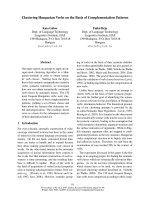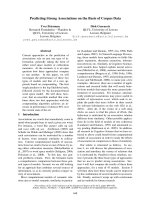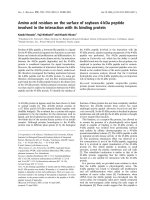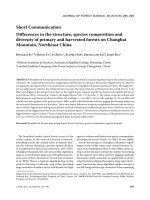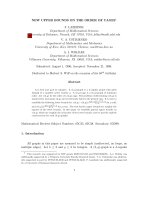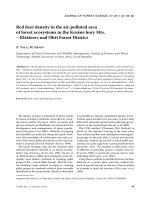Báo cáo lâm nghiệp: "Forest visitors’ opinions on the importance of forest operations, forest functions and sources of their financing" docx
Bạn đang xem bản rút gọn của tài liệu. Xem và tải ngay bản đầy đủ của tài liệu tại đây (177.43 KB, 5 trang )
266 J. FOR. SCI., 57, 2011 (6): 266–270
Forest visitors’ opinions on the importance of forest
operations, forest functions and sources of their financing
L. Š
Faculty of Forestry and Wood Sciences, Czech University of Life Sciences Prague,
Prague, Czech Republic
ABSTRACT: The survey was conducted in three selected areas of the Czech Republic in 2008, with the results pro-
cessed in 2009. Forests visitors received inquiry forms (face to face interviews, random sample). The total number of
visitors on 8 survey days was 7,369. The total number of filled-in questionnaires in the three areas was 1,122. Tree
planting and tree protection are considered as the most important forest operations, followed by road and stream
bank maintenance. On the contrary, timber transport and harvesting are considered as the least important activities.
The nature-protecting function is considered as the most important forest function, followed by soil-conservation,
climatic, hydrological and health (recreational) functions. Timber production and non-timber production are the
least important functions according to the respondents. 20% of respondents claimed that increased costs needed to
improve non-market forest functions, used by the visitors, should be partially or fully financed from the timber sales
revenues, while only 6.5% of respondents say the costs should be partially or fully financed from payments by the
users of forest functions.
Keywords: Czech Republic; forest functions; forest operations; importance; sources of finance
JOURNAL OF FOREST SCIENCE, 57, 2011 (6): 266–270
Supported by the Ministry of Agriculture of the Czech Republic, Project No. QH71296.
An objective survey of what forest visitors know
about the issues in question is a very important
informative source for forest policy and forestry
public relations plans and activities. Many inhab-
itants of the Czech Republic (CR) are keen forest
visitors, and are obviously influenced by all kinds of
information, media, family and school education.
It is rather complicated to inquire about visitors’
opinions on forest functions, on the importance of
forest operations and on sources of financing for-
est functions. e questions in the survey have to
be appropriately formulated, as most forest visitors
are not acquainted with the issues of forestry, forest
functions and their providing.
e survey is a part of a Research Project support-
ed by the Grant Agency of Lesy ČR, state enterprise
(Forests of the Czech Republic, FCR) Evaluation of
the socio-economic importance of recreational forest
functions in selected areas of the FCR in 2007–2009
(Š et al. 2009; P, Š 2009). Me-
thodical support of both theoretical and practical
aspects of the survey came from Research Project
No. QH71296 System of evaluation of the impor-
tance of socio-economic forest functions including
criteria and indicators of multifunctional forest
management. e structure of forest functions and
their evaluation have been discussed in many publi-
cations; systems of forests functions are also mani-
fold (lately, for example: M, C 2005;
M et al. 2008; Č et al. 2010). e sur-
vey also made use of previous research projects in
this field in the Czech conditions (Š 1996, 2006;
R 1997; Š et al. 2007). e structure of
forest functions was formulated in accordance with
what the forest visitors in the CR know about forest
and its functions. Forest visitors’ opinions on the re-
spective issues were surveyed for the first time in the
CR. Nevertheless, the visit rate in the forests of the
CR has been monitored annually since 1994 (Š
et al 1997; Š, P 2009), though only in
the framework of the whole CR, using a representa-
tive sample of respondents (quota sample).
J. FOR. SCI., 57, 2011 (6): 266–270 267
MATERIAL AND METHODS
e survey was conducted in three selected ar-
eas of the CR in 2008, with the results processed
in 2009. Forest visitors received inquiry forms (face
to face interviews, random sample). Properly in-
structed surveyors at 12 signposted stands in se-
lected localities distributed inquiry forms to visi-
tors who filled them in. e surveyors explained
any unclear points to the respondents. Visitors
were asked not only to share their opinions but also
to provide basic personal information (age, sex, ed-
ucation, population of their home town or village,
distance from the selected area).
ree localities were selected, all with an above-
average forest visit rate and high recreational and
tourist importance. e localities included a moun-
tain area (Nová Louka in the Jizerské hory Mts. in
the north of CR), a highland area (Pasecká skála
in the Czech-Moravian Highlands in the central
part of CR) and a lowland forest (Knížecí les in the
south-eastern part of CR by the Svratka River).
Data were collected in the selected localities on
eight days in 2008. To be methodologically compat-
ible, the survey was carried out on the same days of
the week, one half of the days being weekdays, the
other half being weekend days, in all four seasons
of the year (spring, summer, autumn, winter). e
questions were worded as follows:
(1) To what extent is it necessary to carry out forest
operations, with their classification into timber
transport, protection and maintenance of stream
banks in forests, young tree protection, road
maintenance, tree planting and timber harves-
ting. e respondents were asked to mark the
importance on a scale from 1 (the most impor-
tant) to 5 (the least important).
(2) What functions should be provided by the
Forests of the Czech Republic, with their clas-
sification into timber production, non-timber
production, hydrological functions, soil con-
servation, and climatic, health (recreational) and
nature protection functions. e respondents
were asked to mark the importance on a scale
from 1 (the most important) to 5 (the least im-
portant).
(3) What source of finance should be used for
covering the costs of increased realization of
non-market forest functions – from timber
sales revenues, from state budget, other public
budgets, international sources, payments from
users of forest functions. e respondents ticked
off one of the three alternatives: fully, partially,
not at all.
e importance of forest operations and the real-
ization of forest functions by the FCR were marked
using a five-mark scale: 1 – the most important;
5–the least important. e order of importance
1–5 was adjusted according to the weight of the
number of respondents’ answers, like in the case
of some forest operations and forest functions to
which the respondents attributed low importance
or in which the number of answers was very low,
especially in the case of low importance (4, 5), and
that degraded the importance of the respective ac-
tivities even more. e adjusted order takes into
account this influence.
RESULTS
In all, the surveyors counted 7,369 visitors on
8census days, from 8 a.m. to 4 p.m. (4 weekdays
–Wednesday and 4 weekend days – Saturday). Out
of them, 36% of visitors were counted in winter
season, 30% in summer season, over 29% in spring
season and less than 5% in autumn.
In the three localities together, 1,122 question-
naires were filled in, 30% of respondents rejected to
answer the questions, the main reason being their
lack of time (especially in the case of bikers and ski-
ers). On average, for almost 16% visitors it was their
first visit to the locality, 40% visit the locality once
or twice a year and 44% more often. It means that
the localities are quite popular and many visitors
return there. It might be an important fact for pub-
lic relations development.
Another important factor for PR might be the
education of forest visitors in the respective areas.
37%of visitors were persons with university degree
(CR claims 9% of the population with university de-
gree), 41% had secondary education with graduation
examination (28% in CR), only 15% of visitors had
secondary education without graduation examina-
tion (though it is 38% in CR) and 7% of visitors had
only primary education (23% in CR). It implies that
the education of visitors, albeit slightly distorted
by the random sample and by possible willingness
or unwillingness to fill in the form, is substantially
higher than the average of the population in CR.
e size and population of the visitors’ home
town or village is another important factor for PR
and for evaluation of their knowledge and opinion
on forests and forest management. e localities
were visited by 19% of people coming from Prague
(the population over 1 mil.) while Prague citizens
account only for 12% of the Czech Republic popu-
lation. Visitors from cities with over 100 thousand
268 J. FOR. SCI., 57, 2011 (6): 266–270
citizens accounted for 21%, while their percentage
in CR is only 12%.
Importance of forest operations
Respondents consider tree planting and tree pro-
tection as the most important forest operations.
Road and water stream protection and maintenance
follow, while timber transport and timber harvest-
ing are considered the least important (Fig.1).
Forest operations can be related, to a certain ex-
tent, to forest functions as timber harvest and timber
transport are related to the forest function of timber
production, and there is also a link between the other
particular operations and individual environmental
and/or social forest functions. No significant differ-
ence between the opinions of forest visitors from
large cities and from rural areas was determined.
Importance of realization of forest functions
Among the forest functions that should be pro-
vided by the FCR is nature protection at the first
place, followed by soil conservation, climate pro-
tection, hydrological function, health (i.e. recre-
ational) function, timber production function and
finally non-timber production function (Fig. 2).
Reimbursement of costs of increased
non-market forest functions
For the first time in CR, respondents were asked
about possible financial sources for the increased
costs of improved non-market forest functions
of which they are users and which do not bring
any revenues. eir suggestions are surprising.
6.3% of respondents suggested that the improve-
Fig. 2. Importance of forest
functions (scale of order:
1 – the most important,
5 – the least important)
Fig. 1. Opinions on the importance of forest
operations (scale of order: 1 – the most im-
portant, 5 – the least important)
Timber Non-timber Hydrological Soil Climate Health-hygienic Nature
production production function protection protection function protection
function function function function function
1.0
1.5
2.0
2.5
3.0
3.5
4.0
4.5
5.0
Timber Water Trees Roads Trees Timber
transport streams protection repaiment planting harvesting
protection and maintenance
and maintenace
1.0
1.5
2.0
2.5
3.0
3.5
4.0
4.5
5.0
J. FOR. SCI., 57, 2011 (6): 266–270 269
ment of non-market forest functions which they use
should be fully financed from timber sales revenues,
13.7%partially from timber sales revenues and only
1.3% claim they should not be financed from timber
sales revenues. It means that 20% of forest visitors
in CR who use non-market forest functions want to
transfer the costs of such improved forest functions
to the forest function of timber production which is,
nevertheless, significantly limited and even impaired
by their demands as they increase the costs of timber
production and lower the revenues. By persisting on
these suggestions the respondents would paradoxi-
cally destroy the market basis, in other words the
suggested source of financial means for non-market
forest functions (Table 1).
When public sources are concerned, 5.5% of re-
spondents prefer financing the non-market forest
functions fully from the state budget, 15.0% partial-
ly from the state budget, and only 1.2% suggest not
to cover the costs from the state budget at all. Only
1.4% of respondents want to cover the costs of non-
market forest functions fully from regional and
municipal budgets, 15.3% partially, and 2.9%not at
all. 1.6% of respondents suggest covering the costs
of non-market forest functions fully from interna-
tional sources (EU), 10.3% partially, and 6.5% not
at all, even though the beneficial and wholesome
effects of non-market forest functions are used es-
pecially by home respondents.
It is also surprising that only few respondents
are willing to pay directly for the non-market for-
est functions. Only 0.8% of respondents agree that
the increased costs of improved non-market forest
functions should be covered from payments by us-
ers of forest functions; only 5.7% suggest at least
the partial coverage of these costs from payments
by users of forest functions. As many as 11.0% of
respondents think that the costs of improved non-
market forest functions should not be paid for by
their users at all.
ese opinions are very surprising and in this
sense they contradict the principles of market
economy. It is necessary to seriously consider them
in respective PR activities and keep surveying them.
CONCLUSION
e survey confirmed that all three localities, i.e.
Nová louka, Pasecká skála and Knížecí les, have a
high turnout of visitors. Numbers of visitors vary
to some extent according to different size, acces-
sibility, recreational and sports facilities and rec-
reational attractiveness of the localities. e most
important forest operations, according to respon-
dents, are tree planting and protection followed by
road and water stream bank maintenance. Timber
transport and timber harvesting are considered as
the least important activities (differences among
the localities are insignificant). e most important
forest function to be provided by the FCR is the
function of nature protection followed by soil con-
servation, climatic, hydrological, health (i.e. recre-
ational) function, and timber production function
(their importance is descending only slightly). e
least importance is assigned to the non-timber pro-
duction function (rather low importance in com-
parison with the previous functions). Differences
among the localities are insignificant. It means that
the respondents who came to the forest seeking
recreation and relaxation advance their interests
(though maybe inadvertently) and they may also be
influenced by the information environment in CR.
e opinion on forest operation importance is
though incompatible with the visitors’ opinion on
the coverage of increased costs of non-market for-
est functions. 20% of respondents suggest that non-
market forest functions they use should be fully or
partially financed from timber sales revenues. A
larger proportion of respondents think that the in-
Table 1. Sources of finance for non-market forest functions from the point of view of the visitors (frequency and
percentage of respective classes)
Source of finance
Frequency Percentage
totally partially not at all totally partially not at all
Revenues from timber sales 261 567 52 6.3 13.7 1.3
State budget 229 620 48 5.5 15.0 1.2
Other public budgets 59 632 118 1.4 15.3 2.9
International sources 65 426 269 1.6 10.3 6.5
Payments by forest functions users 31 237 454 0.8 5.7 11.0
Not known 63 1 1 1.5 0 0
270 J. FOR. SCI., 57, 2011 (6): 266–270
creased costs of non-market forest functions they
use should be covered from public budgets – state,
regional or municipal budgets as well as interna-
tional budgets. On the other hand, most respon-
dents disapprove of covering the increased costs
of improved non-market functions from payments
by the users (differences among the localities are
insignificant).
Forest visitors apparently adhere to the opinion
that increased costs of forest functions they use
should be paid for by someone else than the us-
ers, but such an attitude poses a problem in market
economy and society and reflects fixed stereotypes
of the past. e survey implies substantial ambigu-
ity, lack of objectiveness and incoherency of opin-
ions and attitudes of the respondents, possibly
caused by ignorance and misinformation brought
about by school education (and education in gen-
eral) and mass media on the socio-economic multi-
functional nature of forests and forest management.
e survey clearly shows the opening gap that
needs the attention of PR in the forestry sector. It is
necessary to improve communication between the
forestry sector and the public, to support education
and objective information about the real socio-
economic conception of forest functions and their
financing. e results of the survey have to be veri-
fied and analyzed by further research in this field.
References
Č V., T J., M M. et al. (2010): Re-
search, classification and application of forest functions
in landscape. Report for the final opponency of a research
and development project. National Forest Centre, Forest
Research Institute, Zvolen: 267. (in Slovak)
M R. et al. (2008): Study on the Development and
Marketing of Non-Market Products and Services. [Study
Contract N: 30-CE-0162979/00-21.] DG AGRI: 127.
M M., C L. et al. (2005): Valuing Mediterra-
nean Forests. Towards Total Economic Value. Wallingford,
CABI Publishing: 406.
P V., Š L. (2009): Forest frequentation in
chosen localities of the Czech Republic. In: M R.,
K Z., T E., H M. (eds):
Proceedings of the Conference Forest, Wildlife and Wood
Sciences for Society Development. Prague, 16.–18. April
2009. Prague, Czech University of Life Sciences, Faculty of
Forestry and Wood Sciences: 223–230.
R I. (1997): Investigation of the Czech Republic inhabit-
ants attitudes to forest and forestry management. [Research
report.] Prague, Faculty of Forestry of CULS Prague: 65.
(in Czech)
Š L. (1996): Forest frequentation by inhabitants of Czech
Republic. Lesnictví-Forestry, 42: 245–253. (in Czech)
Š L. (2006): Importance of non-wood forest product
collection and use for inhabitants in the Czech Republic.
Journal of Forest Science, 52: 417–426.
Š L., P K. (2009): Social Importance of Non-
maket Forest Production and Collection in Czech Republic
– Fiften Years of Systematic Investigation. Praha, Grada
Publishing, a.s.: 110. (in Czech)
Š L., P K., K V. (1997): Importance of
forest frequentation and main non-timber forest products
collection by inhabitants of areas with forests affected by
immissions. Lesnictví-Forestry, 43: 245–258. (in Czech)
Š L., Š F., K V., Š V., P K.,
Č V., S J. (2007): System of valuation of
socio-economic forest functions importance including cri-
teria and indicators of multifunctional forest management.
Periodical report. [Research Project QH71296.] Prague.
Faculty of Forestry and Wood Sciences of the CULS Prague:
105. (in Czech)
Š L., P K., P V., S R., V-
K., S J. (2009): Valuation of recreational
forest functions socio-economic importance in selected
areas of the Forests of Czech Republic, state enterprise.
[Research Report.] Prague, Czech University of Life Sci-
ences Prague, Faculty of Forestry and Wood Sciences: 118.
(in Czech)
Received for publication December 6, 2010
Accepted after corrections March 21, 2011
Corresponding author:
Prof. Ing. L Š, CSc., Czech University of Life Sciences Prague, Faculty of Forestry and Wood Sciences,
165 21 Praha 6-Suchdol, Czech Republic
e-mail: sisak@fld.czu.cz
